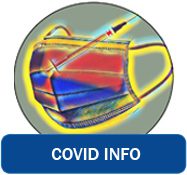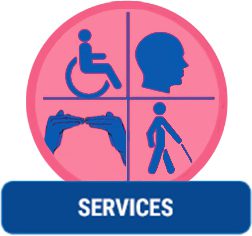RUTH E. FINLEY (1923-2002) – DMC Original Governance Chair
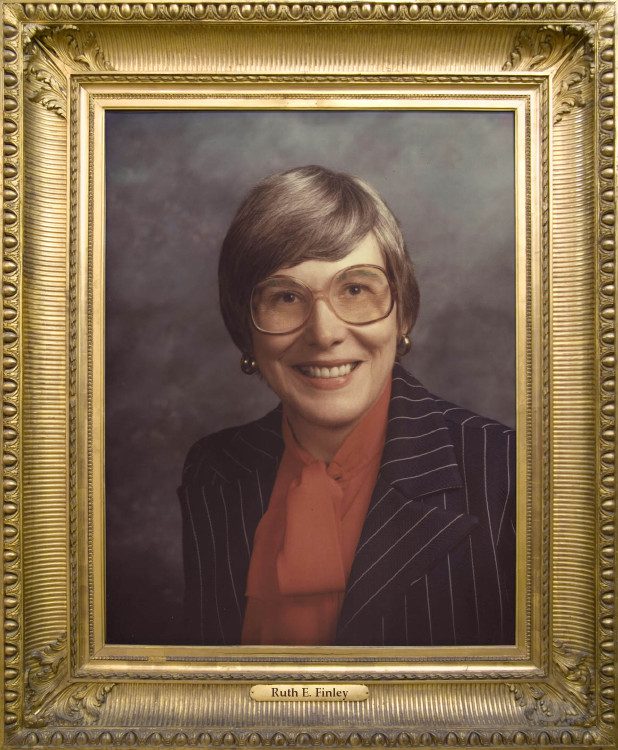
Photo courtesy of the City of Huntington Beach
Ruth Finch was born in Ramsey, New Jersey on November 30, 1923. Early on in her youth, she learned that adversity equaled growth, after enduring the loss of her mother. She had to grow up fast, being raised by a single father. Finch was determined to carve out a path for herself and make her own way. Having a career meant she needed an education.
She attended Columbia University’s Barnard College, a private women’s liberal arts college in the borough of Manhattan in New York City, earning an English degree. From here she set her sights on making a trek 3,000 miles west to North Hollywood, California in 1951 at the age of twenty-eight.
Finch took on office work at United Productions of America, an animation studio which was born as Industrial Film & Poster Service, who produced WWII training films. The company was founded when former Disney employees decided to strike in 1941. The studio would later go on to produce theatrical shorts and the syndicated Mr. Magoo TV series. Finch was one of the few women, working in the primarily male-dominated entertainment industry working in production offices.
While in North Hollywood, Finch found her own love story playing tennis. However, instead of ‘love’ meaning zero in the tennis scoring of the sport, love translated to a win meeting pharmacist husband, Gerald Finley. They married in 1954 and Ruth Finch became Ruth Finley. In 1965, the two made their move to Huntington Beach, California with their family where Finley would start her journey of creating history.
Transitioning from the entertainment industry to politics was not commonplace for women. But for Finley, it was the common denominator of facts, figures, budgets, and planning strengths she possessed which help make this transition possible – looking at the big picture, just like a production. From education functions to local organizations, Finley was able to apply her skill set to producing things for her local community and later city government, She would find herself entering the political arena after attending a meeting of The League of Women Voters of Orange County (LWVOC), California which is a nonpartisan organization committed to educating the public about elections, the voting process, and political and social issues Finley was a smart leader having her eye on what she wanted to do getting involved with her new community as her goal through improving things for the people.
LWVOC was a central hub of Huntington Beach’s city government leaders including the first five women mayors. Norma Brandel Gibbs, first-ever woman mayor; Harriet M. Weider, second woman mayor; Ruth Bailey, third and seventh woman mayor, Ruth Finley, fourth woman mayor, and Grace Winchell, Huntington Beach’s fifth woman mayor. All of these women belonged to LWVOC and their political work was a sisterhood to move projects forward.
Finley joined the city’s advisory commissions, school boards and environmental organizations and opened up necessary dialogue and information on political issues to educate city voters, all while raising her family, devoting time to a variety of organizations from The Girl Scouts of Orange County; to becoming a Founding Board Member of The Dayle McIntosh Center for the Disabled in 1977 as Governance Chair. Finley’s time working with City Council connected her to early disability advocates including Norma Gibbs, where Dayle McIntosh had served as Secretary on her advisory committee for the disabled. Dayle’s early work with Brenda Premo (Dayle McIntosh’s first Executive Director), OC Board of Supervisor’s assistant Greg Winterbottom.
Serving as Huntington Beach Planning Commissioner, Finley would be involved in numerous projects for the city from May of 1979 through December of 1988. Her accomplishments included being on the Board (she was also founder) of Los Amigos de Bolsa Chica and being on the environmental advisory board. She volunteered at the Huntington Beach Central Library, which Gibbs founded. Finley was passionate about literacy and supported the initiatives for a well-stocked children’s library section to inspire the next generation.
When Finley became Mayor on April 20, 1981, she continued her community service, while continuing on as a city council member simultaneously.

Photo Courtesy of the City of Huntington Beach
While this is a huge milestone for Ruth Finley, she is not the first in her family to be Mayor and to have a park for her namesake and service. Her father’s brother (Ruth’s uncle) Dr. John B. Finch was the first Mayor of her birthplace, Ramsey, New Jersey and he has a park named after him, called Finch Park, located on Church Street which was proposed in December of 1950 by the Ramsey Planning Commission. He was born in 1844 and died in 1897 before she was born.
She didn’t know it at the time, but she had politics and planning in her DNA, taking the path which she was destined to do, and assisted DMC through governance advisory during her time on DMC’s Board.
Ruth Finley passed away on January 14, 2002.
PEGGY METRO (1923-1983) – DMC Original Finance Chair

Peggy J. Hopkins (Metro) was born on January 31, 1923 in Portland (Multhomah) Oregon. After losing her mother when she was just thirteen years old, and with three of her older adult siblings out of the house, she, her father and little sister moved to Texas where she spent a portion of her childhood before they moved to Los Angeles. It was here she attended Occidental College who offered Business and Commerce courses through the Department of Economics, and perhaps not so coincidentally programs through Health Services for the disabled. She had set her sights on a career in finance. She married Joseph J. Metro and moved to La Mirada, California. Her mother-in-law, Theresa Metro was a woman with disabilities.
Peggy bonded with her mother-in-law, having lost her own mother so young and started her own journey working within the disability community through various events in support of Theresa. She was an officer at the California Association for the Physically Handicapped (formerly, CAPH which is now known as Disability Help) in the role of Treasurer and editor of the Beachwood Newsletter. It was here, she met Dayle McIntosh.
McIntosh herself installed Peggy’s mother-in-law, Theresa Metro as President of the CAPH Long Beach-Lakewood Chapter, for her second term of the local area branch of this organization. Peggy continuously worked alongside her mother at CAPH. Theresa faced a lot of challenges as a woman with disabilities, and was friends with McIntosh sharing many similar advocacy goals to move important issues forward showing what could be made possible, something Peggy appreciated.

Theresa (known as Terry in the community) – was appointed to the Board of Directors of the Psychiatric Clinic for Children at Memorial Hospital in Long Beach. She created history there as the only person with disabilities on a 24-member Board, news that McIntosh was thrilled about – just two months before her own death. Terry Metro, spearheaded fundraising projects and advocated for programming to benefit children and is responsible for the very first service center in the area called Disabled Resources Center, Inc. (DRC). The goal beyond this was to address the needs of children ages 2-18, related to housing, education, counseling and later employment and referral with a focus on training as aides/attendants.
When Dayle McIntosh passed away in 1977, she had a vision as Orange County President and Convention Chair to see things through to bring in the Dayle McIntosh Center as a key contributor, introducing Independent Living Center’s services. Peggy quickly joined the Board of Directors for DMC, and holds one of the most unique roles in The Dayle McIntosh Center’s history, being on DMC’s Articles of Incorporation as a Finance Chair and later also as Office Manager for the organization, being the first to go from Board member to employee and at DMC simultaneously, continuing to be an important bridge between the two organizations. Theresa’s work with the DRC would be useful through daughter-in-law Peggy with hope for collaboration cross-resourcing for the youth.
Just a year after McIntosh’s death, in 1978 Brenda Premo who was part of the Diablo Chapter and Peggy Metro (who was also in charge of advertising) integrated a welcome from DMC into the 1978 conference in Irvine, California called “On the Move.” Both Theresa and Peggy Metro were both instrumental in helping to see McIntosh’s preliminary conference planning through prior to her death, with Premo picking up the rest of the pieces making sure DMC had a presence. Peggy headed up the registration for DMC’s official inaugural debut of the center at the conference. She, along with Mick Spencer who was on the DMC Board of Directors as a Member at Large were the representatives at this milestone DMC introductory event. It was here after official incorporation DMC was put on the map being part of the conference. Peggy died at age 60 years old in April 1983 in La Mirada.
DONALD A. NELSON (1940-2010) – DMC Original Fundraising Chair
Donald A. Nelson of Costa Mesa was brought on DMC’s Board of Directors as Fundraising Chair utilizing his hands-on networking and deal-closing skills to assist in planning and strategy with funding and sponsorship efforts. He lived in Orange County for most of his career, working numerous sales jobs. Because of his sales savvy, he was a keen networker making a contribution toward the Dayle McIntosh with his relationships. One of these most important and essential relationships was The United Way organization. DMC was inside of the United Way Plaza in Garden Grove, which sponsored the DMC Newsletter for many years and provided the United Way Boardroom for disability ‘rap sessions’ every Wednesday at 12 Noon so that people with disabilities could connect. United Way supported also provided key funding to help DMC recover from the financial impact of Proposition 13 back in the early fall of 1978, when DMC was just turning the corner toward its one year anniversary. Nelson spent his later years in Pasadena and died in Temple City, California, where he was still connected with United Way as a donor up until his death.
KATHRYN E. “KAY” GODDARD Ph.D. (1941- Present) –DMC Board Member At Large
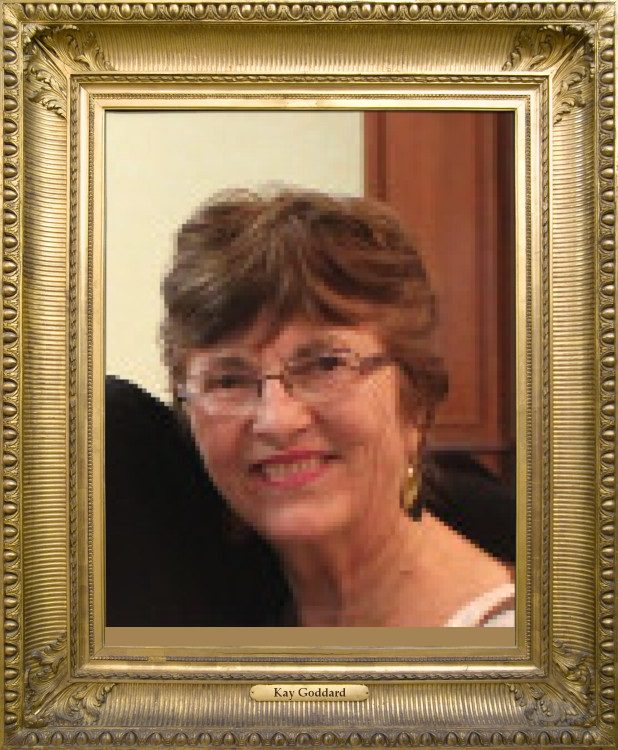
Dr. Kathryn E. “Kay” Goddard is hardworking, highly accomplished and yet the most modest person. When asked at the beginning of this project about the history, of The Dayle McIntosh Center beginnings, she replied:
“It is good that DMC is going to place the history of how it began. We can all learn from understanding what it took for the independent living movement to emerge. I did not know Dayle personally. I began my involvement with DMC because of Brenda Premo. When I served as the Dean of Students at CSULB, I worked with Brenda to create what we then called (1970s) Disabled Students Center. She graduated and had wonderful experiences advocating for the community. When she began the creation of DMC, Brenda involved me as a cheerleader and, ultimately, a member of the Board. Through this involvement I learned a great deal. When Paula Margeson joined the effort, I learned even more.”
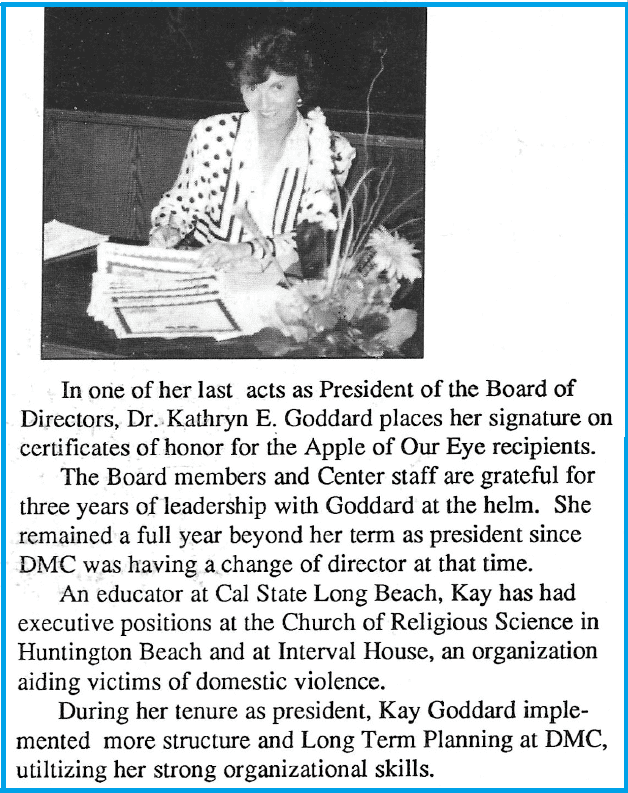
What Goddard did not share was that she holds the record for having spent the longest number of loyal, committed years affiliated with The Dayle McIntosh Center (DMC) being “of service” at the highest level. From joining the mission and cause as one of the earliest of Board Members, she dutifully answered Brenda Premo’s call to be of support as DMC was incubating waiting to be realized; to being President of the Board through 1992 during transitional years of change; and later a Board Member at Large, retiring from DMC’s board in January 2023.
Premo has acknowledged publicly, that if it were not for Goddard working at California State University Long Beach as an educator, being Dean of Students, facilitator and catalyst for change, championing Premo to moving the ‘lunch bunch’ of disabled students on campus forward to have a voice and get involved in creating the Disabled Students Center, a spark and series of events would not have happened to where Premo would meet Dayle McIntosh in the first place.
Additionally, Premo wouldn’t have met key people to rally around her to be able to carry out tasks and carry onward at the tender age of twenty-six without the other activities from CSULB tied to the connections to create the rest of DMC’s Dream Team after Dayle’s passing.
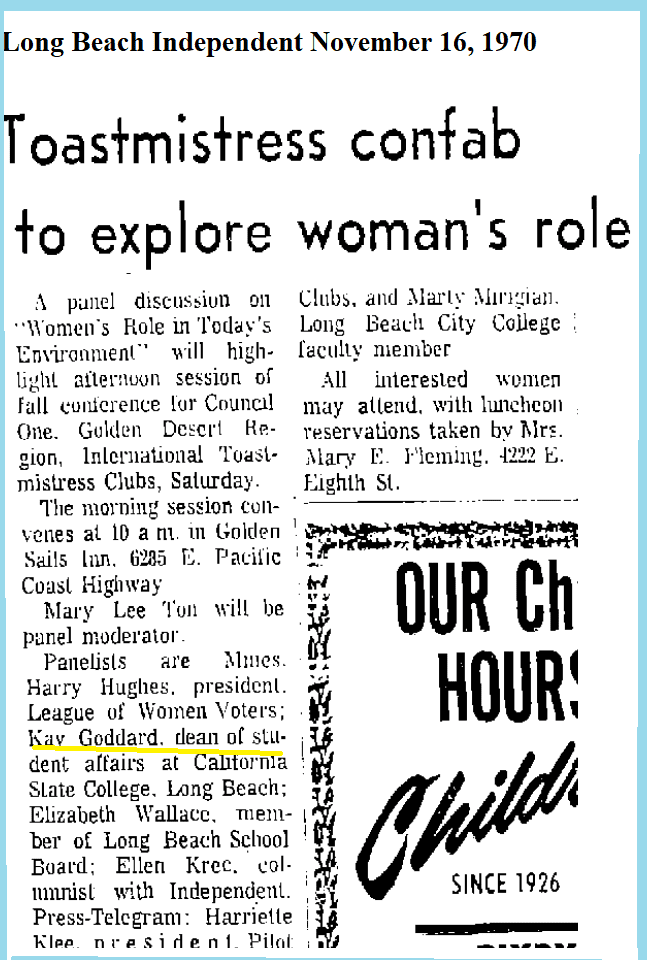
Born in 1941, Goddard wasn’t just born destined for a path to help students have a voice as a future educator, she also always took the opportunity to have a voice herself. She has advocated for students through connection and communication her entire career, and has worked tirelessly as a speaker, an educator and someone who advocates for women’s voices as well, like Premo’s.
Goddard has participated in her own education community, and also has participated on panels, spent much time committed to her work worked in support of her longtime former co-worker and friend, Norma Gibbs throughout Gibbs’ professional endeavors in both Seal Beach and Huntington Beach, along with the Interval House, an organization founded by Gibbs.
Gibbs’ name is peppered throughout DMC history when Dayle McIntosh first worked on Gibbs’ Advisory Committee and is linked to the organization by way of numerous members of the DMC Dream Team. A loyal friend, Goddard was with Gibbs to the very end of Gibb’s life when it ended in 2019.

Featured in this news clip from CSULB Forty-Niner Newspaper Kay Goddard’s work advocating for connection, communication, partnerships and networking collaboration didn’t only serve Cal State University, Long Beach through the years, her work during time on the Board for The Dayle McIntosh Center followed the same philosophy of making connection and exchanging ideas. In addition to her career of accomplishments, Goddard is responsible for the disabled students’ center on CSULB’s campus. Goddard also founded Cal State Long Beach’s Student Development Higher Education (SDHE) program which focuses on future student affairs professionals to address emerging issues and challenges they are likely to face working in two- and four-year institutions. She also has had a fellowship named after her, as well as CSULB’s Board Room and much more. Goddard is responsible for helping to facilitate business guidance and advice throughout her time with The Dayle McIntosh Center. Always an active patron, Goddard physically and financially supports all kinds of passion projects, performing arts, events and has been a patron of the Huntington Beach Library, as well as, DMC throughout all if its years of fundraising events and activities.
MICK SPENCER (1919-1979) – Original DMC Board Member At Large

Born Marwood “Mick” Norman Spencer, April 2, 1919 in Lakota (Kossuth County), Iowa, Mick Spencer was a longtime advocate for the disability community when he became a wheelchair user at 43 years old. Through this acquired disability, he took the lived through barriers and experiences turning them into education and advocacy. Spencer was a founder of California Association of the Handicapped (CAPH) in Orange County and fiercely persistent in bringing important issues to the forefront, and held numerous positions including regional director, State Secretary, State V.P. and developer of OC and Beachwood Chapters of CAPH (where Peggy and Theresa Metro were Board Members). His wife Leona became the first woman to become a lifetime CAPH member.
Spencer worked in the Huntington Beach trenches with Dayle McIntosh all through her time working as part of the Advisory Committee as Secretary to Norma Gibbs. Spencer also worked for the City of Huntington Beach as a member of the Huntington Beach Review Design Board, where they would toil away with Brenda Premo continuing to remove as Spencer would call “architectural barriers.”
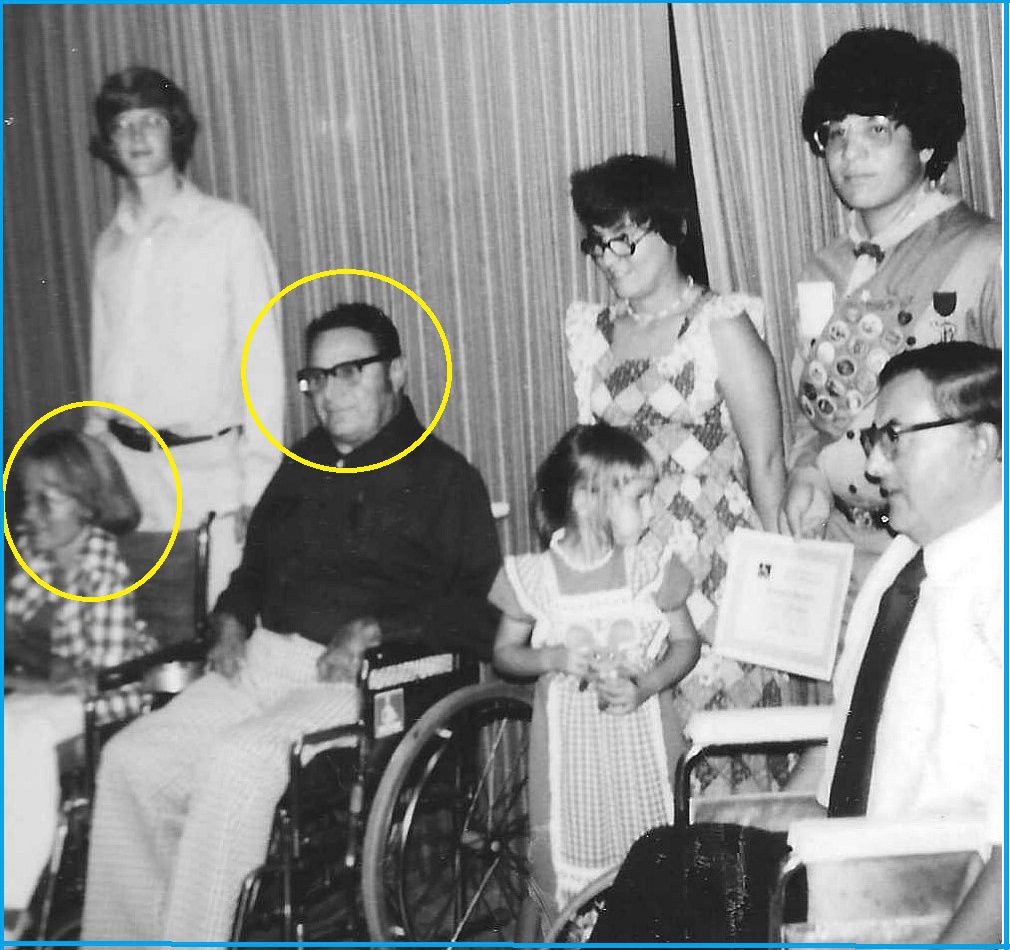
As President of CAPH he kept McIntosh busy as she was editor of the organization’s newsletter. It was because of this, McIntosh dove into her subject matter deeply. What she didn’t realize at the time was Spencer was mentoring her in a way to learn through every story she covered. She became friends with Spencer’s wife, Leona who was Treasurer of CAPH’s OC Chapter. McIntosh worked both sides of being the storyteller and the pitcher with outreach to media to help bring awareness to CAPH’s activities and Spencer’s activities. Paraplegia News gave Spencer an outlet, as the two worked together to share all that Spencer was doing.
Overcoming obstacles started with his travels, finding it difficult to find accessibility while he was adjusting to his new lifestyle. He started his advocacy efforts from a grassroots mail campaign, educating on existing design flaws.
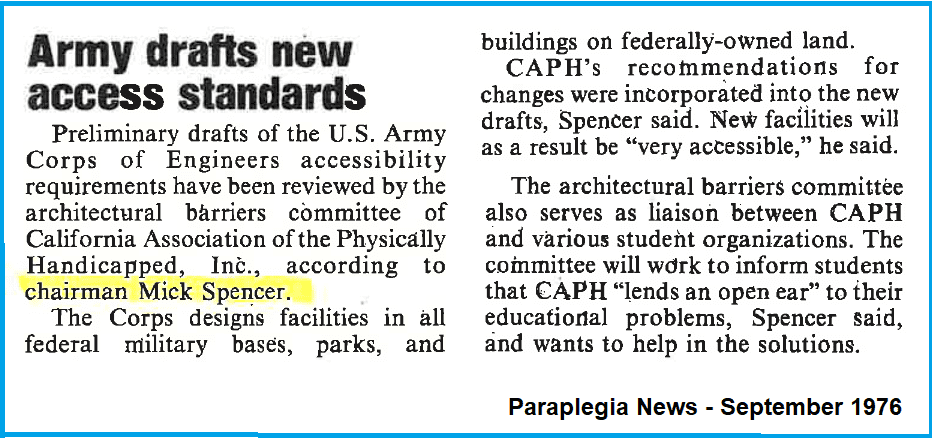
Spencer ended up taking all of his work to the California State level, working as a consultant to architects, and government building officials. He worked as a consultant with the Department of Rehabilitation showing the contrast with a barrier-free design would look like, bringing his education and concepts to life with his own drawings and designs and self-financed this mission in distributing 6,000 copies of ‘reimagining access’ in the name of the disability community access for all.
After working with numerous engineers, architects, government and building officials, service groups, educational organizations and key personnel, he was invited to be a speaker in 1974 at the 3rd annual Seminar of Metropolitan Association of Urban Designers an Environmental Planners, gathering the attention of the United States and Europe, then drafting legislation on housing transportation and employment in Washington, D.C.
There was a reason for this connection – more than anyone knew at the time. Spencer would be taking on a Statewide Vice President role with CAPH, leaving the vacant President role to McIntosh who would end up becoming the OC chapter President until her death. All of her trench work learning through every story she told was like kismet, perfectly poised to be President working so closely with Spencer. This all happened just two years before Spencer’s own passing.
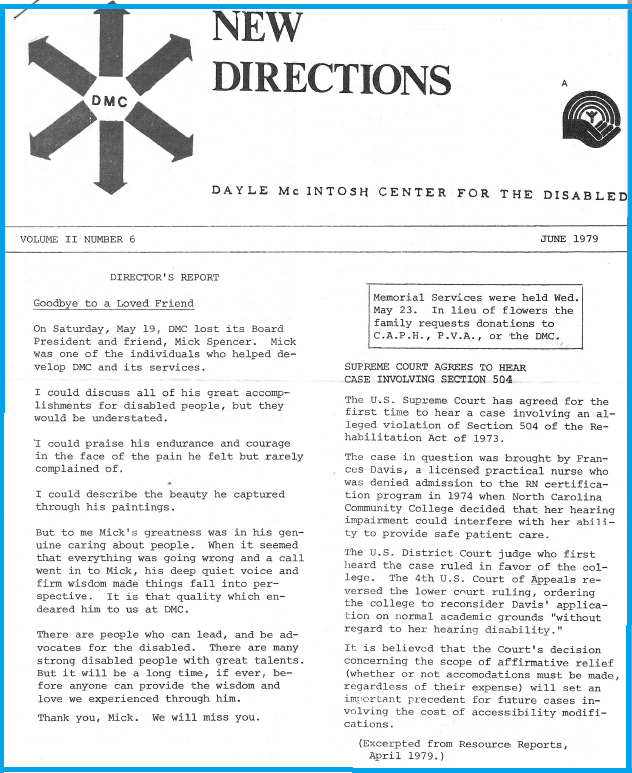
The project that Mick Spencer worked on with Dayle McIntosh and Brenda Premo to make the City of Huntington Beach one of the most accessible cities with curb cuts lives on in Spencer’s name. They all worked tirelessly together on this mission.

Sadly, in a ‘life is poetic’ way, neither McIntosh, nor Spencer would live long enough to see the project through to celebrate the glory of this pioneering hard work– just Premo, who happens be legally blind. Their work lives on for all the future generations who would benefit from the projects, the labor, the activism and advocacy for access.
This spirit remains as what The Dayle McIntosh Center stands for today.



